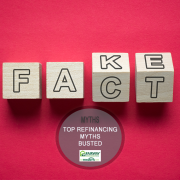Top Refinancing Myths Busted
With current low interest rates, you may have heard that now is a good time to consider refinancing your mortgage. But you may be hesitant to look into the process if you fall victim to these misconceptions. Here are the top 4 refinancing myths – busted.
Top Refinancing Myths Busted
You missed your chance
You may have heard that the Fed is raising interest rates making you wonder if you’ve missed your chance to refinance with a good rate – but don’t worry! Just because the Fed raised rates a smidge, doesn’t mean that refinancing is out of the question. Contact your lender to see if refinancing (even with the higher than anticipated rate) will save you a large amount of money every month. This can be true if your credit score qualifies you for a much lower rate that when you bought the home, or if your home has gained a large amount of equity since you originally bought the home.
You need 20% equity to refinance
This is one of the top refinancing myths out there. While loans with less than 20% equity may require mortgage insurance, you are still eligible for a refinance. For some folks, even with the addition of mortgage insurance, refinancing could still be a good move in the long run.
The application requires a lot of documents
While it’s true that mortgage applications require a good amount of documentation, refinance applications require less time and effort, especially if you go with the lender you first worked with. The process is faster and easier than the traditional loan application since you currently have the existing loan. Yes you’ll need to still provide your bank statements, W2s, previous pay stubs, etc., but the letters of explanation that you first had to send for your loan application are many times omitted.
You have to have cash to close
Refinancing your mortgage includes closing costs similar to the ones you paid when you initially applied for your mortgage. If you don’t want to pay for closing costs upfront, you can take lender credits (which lowers your closing costs but raises your rate), or roll-in these costs by adding them to your mortgage balance. Both choices can drastically reduce your closing costs and make it so you don’t have to have saved up a large amount of cash to complete a refinance for your mortgage.
You may also like: Benefits to Refinancing Your Mortgage







